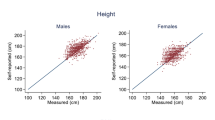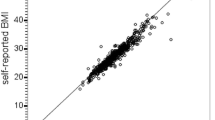Abstract
Objectives: Describe the distribution and direction of self-reported versus measured height and weight using variables associated with aging such as cognition, health status, age, and bone mineral density (BMD), and examine the effect of these measurement differences on body mass index (BMI) classification.Design: Data was derived from the third National Health and Nutrition Examination Survey (NHANESIII) conducted from 1988–1994, a nationwide probability sample.Participants: 4,590 non-institutionalized older adults aged 60 and older.Measurements: Self-reported and measured height and weight, demographic and lifestyle characteristics, BMD, and subscales from the Mini Mental State Exam were used. Values were considered correct if self-reported height was within one inch of measured height, self-reported weight was within 5 lbs of measured weight, and self-reported BMI was within the same classification as measured BMI.Results: Over-reported height increased with age in both men and women, occurring in 70% of those aged 80 and older. Compared to people with normal BMD, a significantly higher proportion of osteoporotic men (76% versus 47%, P < 0.001) and women (52% versus 35%, P < 0.001) over-reported their height. Additionally, significant misclassifications of self-reported height and weight occurred among people in poor health and those with poor performances on memory and calculation tests. Nevertheless, there was agreement in BMI classification among almost 80% of the population and among 90% of individuals in the healthy BMI category.Conclusion: This study suggests that among an older population, self-reported height and weight may be strongly related to age-associated changes in health status, cognition and BMD.
Similar content being viewed by others
References
National Center for Health Statistics. Longitudinal Study on Aging. 1994. Public-use data file and documentation. Available at http://www.cdc.gov/nchs/lsoa.htm. Accessed September, 2006.
National Center for Health Statistics. National Health Interview Survey. 2005. Public-use data file and documentation. Available at http://www.cdc.gov /nchs/nhis.htm. Accessed September, 2006.
Centers for Disease Control and Prevention (CDC). Behavioral Risk Factor Surveillance System Survey Data. Technical Documents and Survey Data. Available at http://www.cdc.gov/brfss/technicaUnfodata/surveydata.htm. Accessed September, 2006.
Stewart AL. The reliability and validity of self-reported weight and height J Chronic Dis 1982; 35: 295–309.
Stewart AW, Jackson RT, Ford MA et al. Underestimation of relative weight by use of self-reported height and weight. Am J Epidemiol 1987; 125: 122–6.
Palta M, Prineas RJ, Berman R et al. Comparison of self-reported and measured height and weight Am J Epidemiol 1982; 115: 223–30.
Hill A, Roberts J. Body mass index: a comparison between self-reported and measured height and weight J Public Health Med 1998; 20: 206–10.
Nieto-Garcia FJ, Bush TL, Keyl PM. Body mass definitions: sensitivity and specificity using self-reported weight and height Epidemiology 1990; 1: 146–52.
Bolton-Smith C, Woodward M, Tunstall-Pedoe H et al. Accuracy of the estimated prevalence of obesity from self-reported height and weight in an adult Scottish population. J Epidemiol Community Health 2000; 54: 143–48.
Spencer EA, Appleby PN, Davey GK et al. Validity of self-reported height and weight in 4808 EPIC-Oxford participants. Pub Health Nutr 2002; 5: 561–5.
Rowland ML. Self-reported weight and height Am J Clin Nutr 1990; 52: 1125–33.
Villanueva EV. The validity of self-reported weight in US adults: a population based cross-sectional study. BMC Public Health 2001; 1: 11.
Kuczmarski MF, Kuczmarski RJ, Najjar M. Effects of age on validity of self-reported height, weight and body mass index: findings from the Third National Health and Nutrition Examination Survey, 1988–1994. J Am Diet Assoc 2001; 101(1): 28–34.
US Department of Health and Human Services (DHHS). National Center for Health Statistics. Third National Health and Nutrition Examination Survey, 1988–94, Reference manuals and reports (CD-ROM). Hyattsville, MD: Centers for Disease Control and Prevention, 1996.
US Department of Health and Human Services (DHHS). National Center for Health Statistics. Plan and Operation of the Third National Health and Nutrition Examination Survey, 1988–94. Vital Health Statistics 1(32), DHHS Publ No. (PHS) 94–1308. Hyattsville, MD: NCHS, 1994.
World Health Organization. Obesity: Preventing and Managing the Global Epidemic: Report of a WHO Consultation on Obesity. Geneva, World Health Org (publ. no. WHO/NUT/NCD/98.1), 1997.
Looker AC, Orwoll ES, Johnston CC Jr et al. Prevalence of low femoral bone density in older US adults from NHANES III. J Bone Miner Res 1997; 12: 1761–8.
Niedhammer I, Bugel I, Bonenfant S et al. Validity of self-reported weight and height in the French GAZEL cohort. Int J Obes 2000; 24: 1111–18.
Flood V, Webb K, Lazarus R et al. Use of self-report to monitor overweight and obesity in populations: some issues for consideration. Aust NZ J Public Health 1999; 24: 96–9.
Sorkin JD, Muller DC, Andres R. Longitudinal change in height of men and women: implications for interpretation of the body mass index: the Baltimore Longitudinal Study of Aging. Am J Epidemiol 1999; 150: 969–77.
Payette H, Kergoat MJ, Shatenstein B et al. Validity of self-reported height and weight estimates in cognitively-intact and impaired elderly individuals. J Nutr Health Aging 2000; 4: 223–28.
Gillum RF, Sempos CT. Ethnic variation in validity of classification of overweight and obesity using self-reported weight and height in American women and men: the Third National Health and Nutrition Examination Survey. Nutr J 2005; 4: 27.
Author information
Authors and Affiliations
Corresponding authors
Rights and permissions
About this article
Cite this article
Sahyoun, N.R., Maynard, L.M., Zhang, X.L. et al. Factors associated with errors in self-reported height and weight in older adults. J Nutr Health Aging 12, 108–115 (2008). https://doi.org/10.1007/BF02982562
Received:
Accepted:
Issue Date:
DOI: https://doi.org/10.1007/BF02982562




